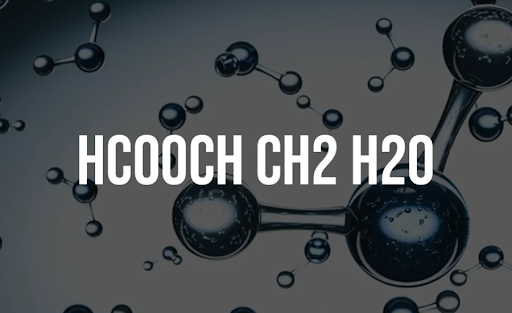Unveiling the Chemistry Behind HCOOCH CH2 H2O: Mechanism, Uses, and Industrial Significance
When you search for “hcooch ch2 h2o”, you’re diving into the fascinating world of chemical hydrolysis—specifically the reaction of methyl formate (HCOOCH₃) with water (H₂O). This reaction plays a crucial role in organic chemistry, pharmaceuticals, industrial synthesis, and even environmental chemistry. In this article, we’ll explore the full reaction mechanism, the practical implications, and how understanding this simple-looking reaction opens doors to larger innovations in science and manufacturing.
Understanding the Reactants: What Is HCOOCH₃ and Why It Matters
Methyl formate, also represented as HCOOCH₃, is a simple ester derived from formic acid and methanol. It’s a colorless liquid with a characteristic ether-like odor. Esters like HCOOCH₃ are fundamental in organic chemistry due to their reactivity and applications in synthetic pathways.
On the other hand, H₂O (water) is the universal solvent that facilitates a wide array of chemical reactions, including hydrolysis. When we combine HCOOCH CH2 H2O in a controlled setup, the reaction demonstrates the conversion of methyl formate into formic acid and methanol, key intermediates in both lab and industrial settings.
Reaction Mechanism: Hydrolysis of Methyl Formate with Water
The central reaction of hcooch ch2 h2o can be represented as:
HCOOCH₃ + H₂O → HCOOH + CH₃OH
Here’s what happens at the molecular level:
- Nucleophilic attack: Water acts as a nucleophile, attacking the carbon in the ester bond.
- Transition state: A tetrahedral intermediate forms during the process.
- Bond cleavage: The C–O bond in the ester breaks, resulting in the formation of formic acid (HCOOH) and methanol (CH₃OH).
This is a textbook example of acid-catalyzed ester hydrolysis, though it can also proceed under basic conditions in a process known as saponification.
Thermodynamics and Kinetics of the HCOOCH CH2 H2O Reaction
The hydrolysis reaction is exothermic, meaning it releases heat. It’s favored under aqueous conditions, especially when heated or catalyzed by acids like HCl or sulfuric acid. In industrial reactors, parameters such as temperature, pH, and reactant concentration are tightly regulated to maximize conversion rates and ensure product purity.
From a kinetics standpoint, the reaction rate is influenced by:
- The concentration of H₂O
- Presence of acid or base catalysts
- Temperature and pressure conditions
Industrial Applications of the Hydrolysis of Methyl Formate
Understanding the reaction hcooch ch2 h2o isn’t just an academic exercise. It has numerous real-world applications:
- Formic Acid Production: Used in leather processing, dyeing textiles, and as a preservative in animal feed.
- Methanol Sourcing: Widely used in fuel, antifreeze, and as a solvent in labs.
- Polymer Industry: Methyl formate hydrolysis is a step in producing formamide and related intermediates for polymer synthesis.
- Agrochemical Industry: Serves in the synthesis of pesticides and herbicides.
- Pharmaceuticals: Formic acid is used to prepare various active pharmaceutical ingredients (APIs).
Green Chemistry and Sustainability Considerations
The reaction involving hcooch ch2 h2o aligns with principles of green chemistry. Since water is the solvent and by-products (formic acid and methanol) are both useful and biodegradable, the process offers a low environmental footprint.
Industries are increasingly adopting this hydrolysis pathway in closed-loop systems where waste is minimized and outputs are recycled or repurposed. Moreover, researchers are exploring biocatalysts (enzymes) to further enhance the reaction under mild, eco-friendly conditions.
Advanced Mechanistic Insights: Catalysts and Optimization
Researchers have studied various catalytic systems for this reaction:
- Brønsted acids (e.g., H₂SO₄): Speed up the reaction by donating protons to stabilize intermediates.
- Lewis acids (e.g., ZnCl₂): Promote nucleophilic attack.
- Enzymatic catalysts: Esterases and hydrolases work under biological conditions to perform the same reaction efficiently.
Catalyst selection depends on the desired rate, yield, and environmental considerations.
Laboratory Applications and Safety Protocols
In the lab, hydrolysis of HCOOCH₃ is often used as a demonstration of ester reactions. Due to the flammability of methanol and the acidity of formic acid, lab safety is essential:
- Use proper ventilation.
- Wear gloves and goggles.
- Handle methyl formate in fume hoods due to its volatility.
Also, waste disposal must follow environmental guidelines, as uncontrolled release of methanol can be hazardous.
Real-World Case Studies: HCOOCH CH2 H2O in Action
- Plastic Production: Companies synthesize biodegradable plastics using intermediates derived from methyl formate hydrolysis.
- Perfume Industry: Methanol derived from the reaction is used to create aroma compounds.
- Leather Industry: Formic acid helps in tanning hides and controlling pH levels during processing.
Each case highlights the economic and ecological value of this reaction.
Educational and Research Value
The hcooch ch2 h2o reaction is taught in high school and university-level organic chemistry courses. It serves as a basis for understanding:
- Esterification and hydrolysis balance
- Reaction mechanisms
- Role of catalysts
- Thermodynamic and kinetic principles
Researchers also use this reaction to model larger systems and optimize batch vs. continuous flow processing.
Conclusion
The hydrolysis of methyl formate with water, summarized by the keyword hcooch ch2 h2o, is more than a simple chemical reaction—it’s a gateway to innovation. Its implications span from industrial manufacturing to green chemistry, pharmaceutical development, and academic research. Whether you’re a student, scientist, or industry expert, understanding this reaction enhances your ability to contribute to safer, more efficient, and sustainable chemical processes.
FAQs on HCOOCH CH2 H2O
Q1. What does the formula HCOOCH CH2 H2O refer to?
A. It represents the hydrolysis of methyl formate (HCOOCH₃) with water (H₂O), producing formic acid and methanol.
Q2. What are the products of methyl formate hydrolysis?
A. The reaction yields formic acid (HCOOH) and methanol (CH₃OH).
Q3. Is this reaction acid or base catalyzed?
A. It can be catalyzed by both acids and bases, though acid-catalyzed hydrolysis is more common in labs and industry.
Q4. Why is HCOOCH₃ important in industry?
A. Methyl formate is used in the production of solvents, foams, and chemical intermediates.
Q5. What is the role of water in this reaction?
A. Water acts as a nucleophile that breaks the ester bond during the hydrolysis process.
Q6. Is the HCOOCH CH2 H2O reaction environmentally friendly?
A. Yes, it’s considered green chemistry because it produces biodegradable and useful products.
Q7. Where is formic acid used?
A. Formic acid is used in leather tanning, dyeing textiles, and preserving animal feed.
Q8. What safety measures are needed for this reaction?
A. Proper ventilation, protective gear, and controlled handling of flammable methanol are essential.
Q9. Can enzymes be used in this hydrolysis?
A. Yes, biocatalysts like esterases can promote the reaction under mild, eco-friendly conditions.
Q10. Is this reaction taught in schools?
A. Yes, it’s commonly included in chemistry curricula to explain ester hydrolysis and reaction mechanisms.




